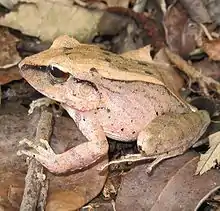Haddadus binotatus
Haddadus binotatus (common name: clay robber frog) is a species of frog in the family Craugastoridae. Haddadus binotatus is a very common frog. It inhabits primary and secondary forest and forest edges. It is usually found in the leaf-litter on the forest floor, or on leaves in low vegetation inside the forest.[1]
| Haddadus binotatus | |
|---|---|
 | |
| Scientific classification | |
| Domain: | Eukaryota |
| Kingdom: | Animalia |
| Phylum: | Chordata |
| Class: | Amphibia |
| Order: | Anura |
| Family: | Craugastoridae |
| Genus: | Haddadus |
| Species: | H. binotatus |
| Binomial name | |
| Haddadus binotatus (Spix, 1824) | |
It is endemic to the Brazilian Atlantic forest and most dominantly found in the states of Rio de Janeiro and Espírito Santo.[2] The density of leaf eating frogs like Haddadus binotatus is higher in Central America than southern America. The Haddadus binotatus is a direct-developing frog and the most abundant species in the community.[3]
Female frogs reach 64 mm (2.5 in) snout–vent length.[4] The female of the species were larger than the males, which may result from the production of larger eggs.[2]
References
- Monique Van Sluys, Carlos Frederico da Rocha (2010). "Haddadus binotatus". IUCN Red List of Threatened Species. 2010: e.T56463A11469352. doi:10.2305/IUCN.UK.2010-2.RLTS.T56463A11469352.en. Retrieved 14 November 2021.
- Coco, L., Borges Júnior, V. N. T., Fusinatto, L. A., Kiefer, M. C., Oliveira, J. C. F., Araujo, P. G., Costa, B. M., van Sluys, M., & Rocha, C. F. D. (2014). Feeding habits of the leaf litter frog Haddadus binotatus (Anura, Craugastoridae) from two Atlantic Forest areas in southeastern Brazil. Anais Da Academia Brasileira de Ciências, 86(1), 239–249. doi:10.1590/0001-37652014113012
- Rocha, C. F. D., Vrcibradic, D., Kiefer, M. C., Siqueira, C. C., Almeida-Gomes, M., Borges Júnior, V. N. T., Hatano, F. H., Fontes, A. F., Pontes, J. A. L., Klaion, T., Gil, L. O., & Sluys, M. V. (2011). Parameters from the community of leaf-litter frogs from Estação Ecológica Estadual Paraíso, Guapimirim, Rio de Janeiro State, southeastern Brazil. Anais Da Academia Brasileira de Ciências, 83(4), 1259–1268. doi:10.1590/S0001-37652011005000036
- Hedges, S. B.; Duellman, W. E. & Heinicke, M. P (2008). "New World direct-developing frogs (Anura: Terrarana): Molecular phylogeny, classification, biogeography, and conservation" (PDF). Zootaxa. 1737: 1–182. doi:10.11646/zootaxa.1737.1.1. Archived from the original (PDF) on 2010-06-10.
